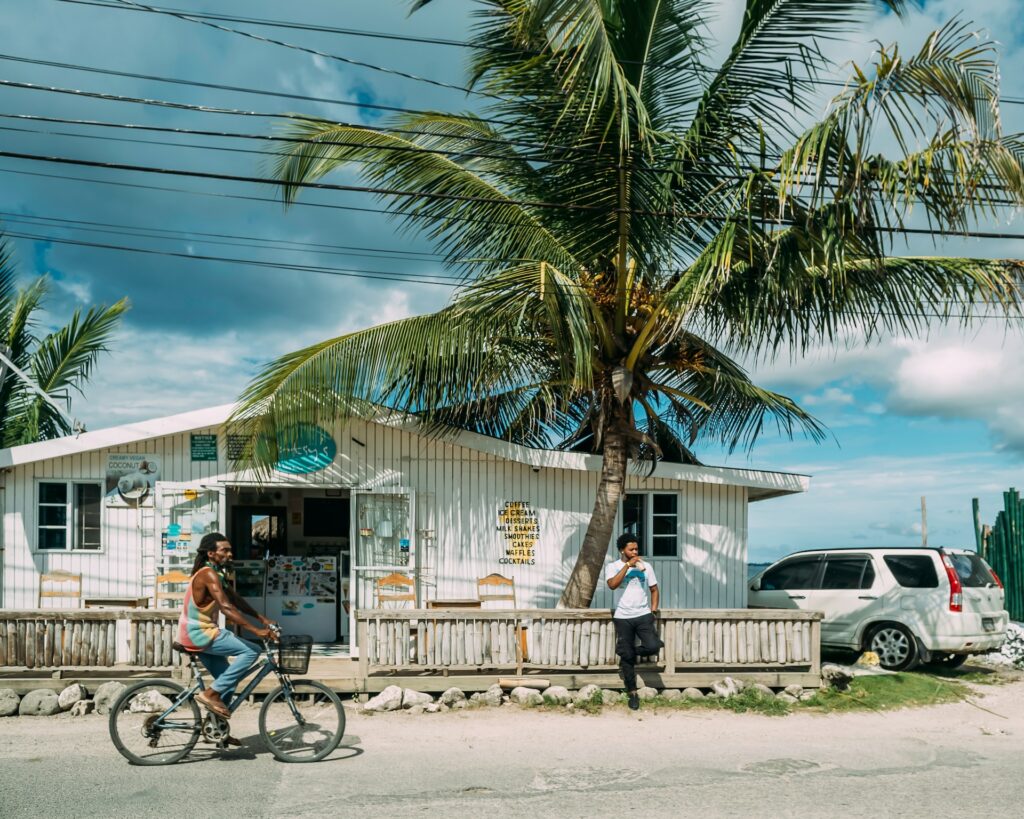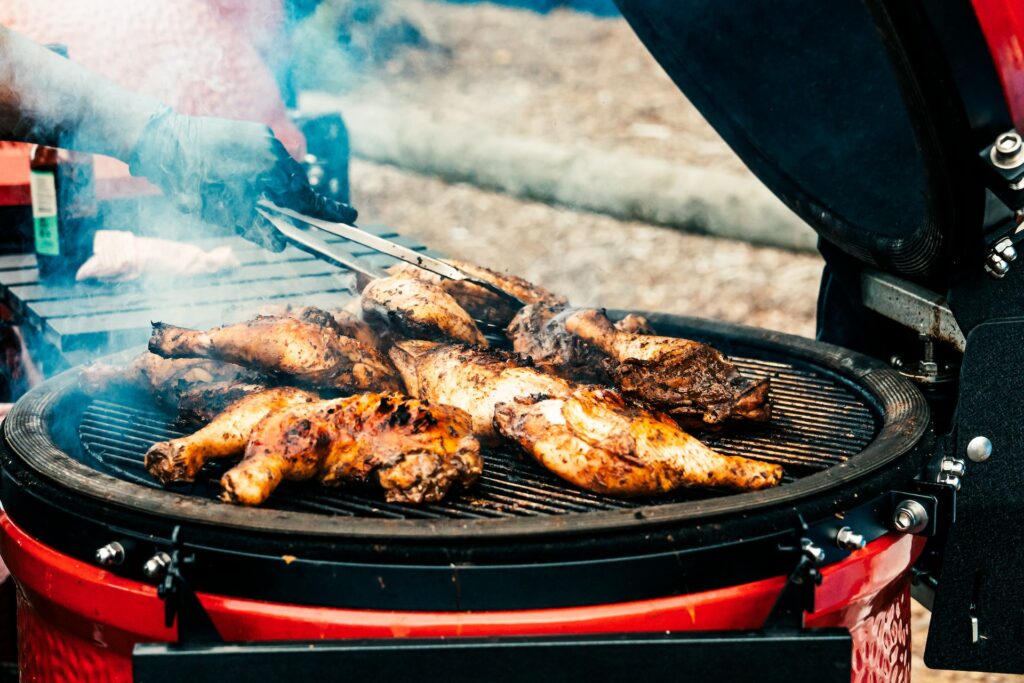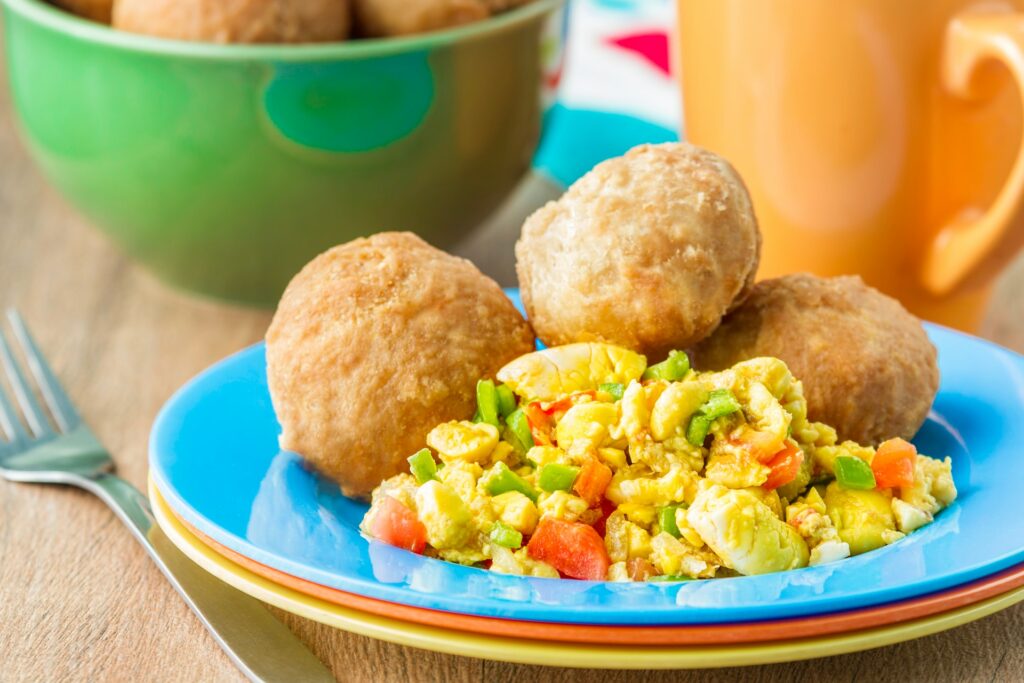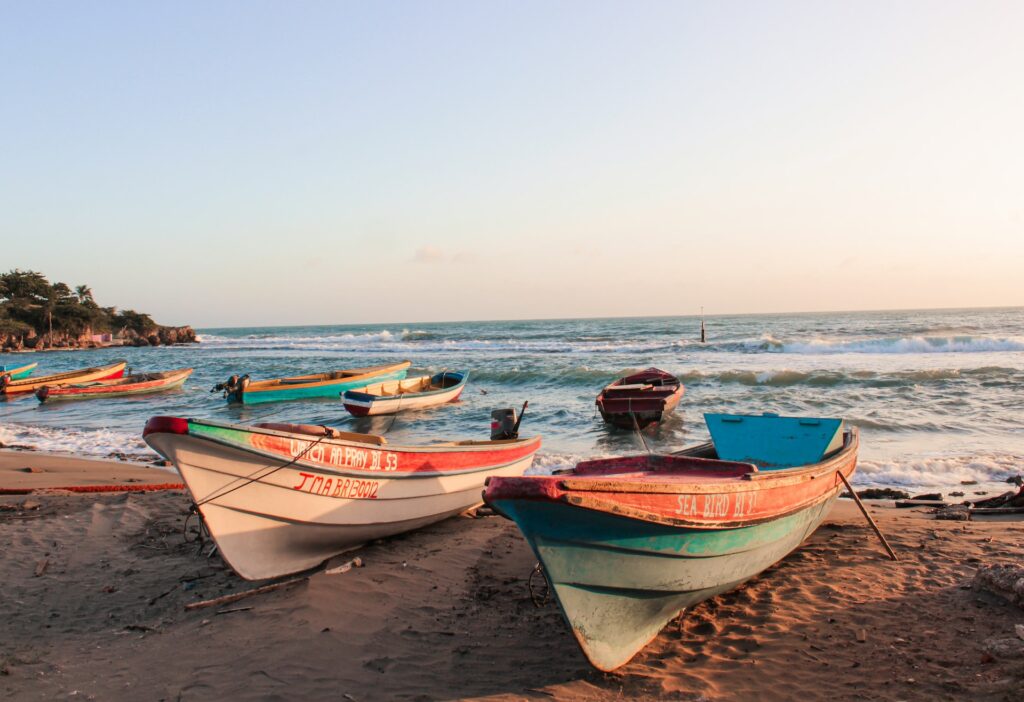Traditional food in Jamaica is a fascinating blend of various culinary influences that have created a unique fusion of flavors. It’s heavily influenced by the island’s African heritage, with additional touches from the Taino people, who were the island’s original inhabitants. Over time, Spanish, British, Indian, and Chinese settlers also left their mark on the local cuisine. The result is a diverse and flavorful food scene that perfectly complements Jamaica’s laid-back atmosphere and stunning landscapes.
The History of Jamaican Cuisine
Understanding the history of traditional food in Jamaica is essential to truly appreciate its flavors and techniques. The island’s culinary roots can be traced back to Africa, as many of the ingredients and cooking methods used today were brought to Jamaica by enslaved Africans. These traditions were then adapted and blended with the culinary practices of the Taino people, the island’s original inhabitants.
When Spanish, British, Indian, and Chinese settlers arrived in Jamaica, they brought their own ingredients and cooking methods, further influencing the local cuisine. This culinary melting pot has given Jamaican food its unique and distinctive flavors.
The Staples of Jamaican Cuisine

Jamaican cuisine is known for its hearty dishes, with rice and peas being one of the most popular staples. This versatile side dish is typically made with rice, red kidney beans, coconut milk, and various aromatic spices. It’s often served alongside various meats and vegetables, making it a versatile and delicious addition to any meal.
Plantains and yams also play an important role in Jamaican cuisine, as they are widely grown on the island and used in various dishes. These starchy vegetables are often boiled, fried, or roasted, adding flavor and substance to many traditional Jamaican meals.
Thanks to the island’s abundant coastline and rich marine life, fish and seafood are also essential to traditional food in Jamaica. From grilled fish to spicy seafood stews, the ocean’s bounty features prominently in many Jamaican dishes.
The Art of Jerk Cooking

Jerk cooking is one of Jamaica’s most iconic culinary traditions. This technique involves marinating meat (usually chicken or pork) in a spicy mixture of Scotch bonnet peppers, allspice, thyme, garlic, and other seasonings before grilling it over an open flame. The result is a smoky, spicy, and incredibly flavorful dish that’s become synonymous with Jamaican cuisine.
Jerk cooking is believed to have originated with the Maroons, escaped African slaves who formed independent communities in the island’s mountains. The word “jerk” is thought to come from the Spanish term “charqui,” which means dried meat, as the Maroons would often preserve their meat using this technique.
Curries and Stews
Indian cuisine has had a significant impact on traditional food in Jamaica, particularly in the form of curries. Curry goat, for example, is a popular dish that combines tender pieces of goat meat with a fragrant blend of spices and herbs. The dish is usually served with rice and peas, making for a hearty and satisfying meal.
Oxtail stew is another favorite in Jamaican cuisine, featuring slow-cooked oxtail in a rich and flavorful gravy. The dish often includes butter beans and a variety of vegetables, such as carrots and chocho (chayote). The tender, succulent meat and comforting flavors make oxtail stew a beloved choice for many Jamaicans.
Traditional Jamaican Dishes
Ackee and Saltfish

Ackee and saltfish is not only a delicious dish but also a significant one, as ackee is Jamaica’s national fruit. The dish consists of ackee, which has a unique, slightly nutty flavor, combined with salted codfish. Together, they create a savory, satisfying meal that is often enjoyed for breakfast or brunch.
The origins of ackee and saltfish can be traced back to the 18th century when the ackee tree was brought to Jamaica from West Africa. Saltfish, on the other hand, was introduced by European settlers and quickly became a popular source of protein on the island. Today, this dish is a staple in Jamaican cuisine and a must-try for any food enthusiast.
Escovitch Fish
Escovitch fish is a delicious Jamaican dish with Spanish roots. It typically features whole fried fish that is then marinated in a tangy, spicy sauce made from vinegar, onions, carrots, and Scotch bonnet peppers. The dish is often served with fried bammy (a traditional cassava flatbread) or rice and peas.
The history of escovitch fish can be traced back to the Spanish settlers who arrived in Jamaica in the 16th century. They introduced the technique of “escabeche,” which involves marinating fried fish in a vinegar-based sauce. Over time, the dish was adapted and became a popular part of Jamaican cuisine, with the addition of local ingredients like Scotch bonnet peppers.
Jamaican Patty
A Jamaican patty is a flaky, golden pastry filled with a variety of seasoned meats, vegetables, or even fruits. These delicious handheld treats have roots in both British and Indian cuisine, as they are similar to the British pasty and the Indian samosa. The most common fillings include spicy beef, chicken, or vegetables, but you can also find more unique options like ackee or lobster.
Jamaican patties are a popular street food and can be found in bakeries, restaurants, and roadside stands all over the island. They make for the perfect snack or light meal while exploring Jamaica’s beautiful sights.
Stamp and Go
Stamp and Go, also known as Jamaican saltfish fritters, is a tasty and convenient snack made from salted codfish, flour, spices, and vegetables like onions and peppers. The fritters are then deep-fried until crispy and golden brown. Stamp and Go is often enjoyed for breakfast or as a midday snack and can be found at local food stalls and markets throughout Jamaica.
The name “Stamp and Go” is believed to have originated from the British Royal Navy, as sailors would often “stamp” their feet and “go” to the next task when eating these quick, portable snacks. Today, Stamp and Go remains a popular and beloved part of Jamaican cuisine.
Bammy and Festival
Bammy is a traditional Jamaican flatbread made from grated cassava, which is soaked, pressed, and then fried or baked. It has a slightly dense texture and a subtle flavor, making it an excellent accompaniment to various dishes, such as escovitch fish or jerk chicken.
Festival, on the other hand, is a sweet and slightly crispy fried dough made from cornmeal, flour, sugar, and spices. It is often served as a side dish with savory meals, adding a touch of sweetness to balance the flavors.
Both bammy and festival are deeply rooted in Jamaican cuisine, with bammy being a Taino staple that predates the arrival of Europeans on the island. Festival, while more recent, has become a popular and beloved addition to many traditional Jamaican dishes.
Jamaican Soups
Red Peas Soup
Red peas soup is a comforting and flavorful dish that showcases the importance of red peas (kidney beans) in Jamaican cuisine. The soup is made with red peas, vegetables, yams, and dumplings, all simmered together in a rich, savory broth. It’s often enjoyed as a main course, providing a hearty and satisfying meal.
The origins of red peas soup can be traced back to African culinary traditions, which were brought to Jamaica by enslaved Africans. Over time, the dish has become a staple of Jamaican cuisine, enjoyed by locals and visitors alike.
Pumpkin Soup
Pumpkin soup is a popular Jamaican dish that highlights the versatility and importance of pumpkin in the island’s cuisine. The soup is made with pumpkin, vegetables, spices, and often includes dumplings or yams, giving it a thick, velvety texture.
There are many variations of pumpkin soup in Jamaica, with each cook adding their own unique touch to the dish. Regardless of the specific recipe, pumpkin soup remains a delicious and healthy option that showcases the flavors and ingredients of Jamaican cuisine.
Jamaican Desserts
Gizzada
Gizzada, also known as “pinch-me-round,” is a sweet and satisfying Jamaican dessert that features a flaky pastry shell filled with a delicious mixture of grated coconut, sugar, and spices. The dessert is believed to have Portuguese origins, as it shares similarities with the Portuguese “queijada.”
Over time, gizzada has become a popular treat in Jamaica, enjoyed by both locals and visitors. The combination of the crisp pastry shell and the sweet, flavorful coconut filling creates a delightful and indulgent dessert.
Grater Cake
Grater cake is a colorful and flavorful Jamaican dessert made from grated coconut, sugar, and food coloring. The mixture is cooked until it reaches a thick, sticky consistency, then spread onto a flat surface and allowed to cool before being cut into small squares.
The origins of grater cake can be traced back to the island’s African heritage, as coconut is a prominent ingredient in many African desserts. Today, grater cake remains a popular and beloved treat in Jamaica, with its vibrant colors and sweet flavors making it a favorite among locals and visitors alike.
Cornmeal Pudding
Cornmeal pudding, also known as “blue drawers” or “tie-a-leaf,” is a warm and comforting Jamaican dessert made from cornmeal, sugar, spices, and coconut milk. The mixture is baked or steamed until it reaches a firm, yet moist, consistency.
The significance of cornmeal in Jamaican cuisine dates back to the Taino people, who used corn as a staple ingredient in their diet. Cornmeal pudding is a delicious and satisfying dessert that showcases the island’s culinary heritage and the versatility of this simple, yet flavorful, ingredient.
Jamaican Beverages

Blue Mountain Coffee
Blue Mountain coffee is one of Jamaica’s most famous and sought-after exports. Grown in the Blue Mountains, which stretch across the eastern part of the island, this coffee is known for its smooth, mild flavor and subtle acidity.
The history of Blue Mountain coffee dates back to the 18th century when coffee was first introduced to Jamaica by the British. Today, it is considered one of the finest coffees in the world, with its unique flavor profile resulting from the high altitude, rich volcanic soil, and cool climate in which it’s grown.
To truly appreciate Blue Mountain coffee, it’s best to enjoy it black, without any added sugar or milk. This allows the coffee’s natural flavors to shine through, providing a memorable and invigorating experience.
Rum Punch
Rum punch is a quintessential Jamaican beverage that showcases the island’s rich history and strong connection to rum production. Made with a combination of rum, fruit juices, and various spices, rum punch is a refreshing and flavorful drink that perfectly captures the spirit of Jamaica.
The origins of rum punch can be traced back to the 17th century when rum production began on the island. The drink quickly gained popularity, both in Jamaica and abroad, as a delicious and potent beverage that embodied the island’s laid-back atmosphere and vibrant culture.
There are many variations of rum punch, with each bartender or home cook adding their own unique touch to the drink. Regardless of the specific recipe, rum punch remains a popular and beloved beverage in Jamaica, perfect for sipping on a sunny beach or at a lively celebration.
The rich and diverse nature of Jamaican cuisine is a testament to the island’s vibrant history, its blend of cultures, and the abundance of local ingredients. From the smoky flavors of jerk cooking to the comforting warmth of a bowl of red peas soup, Jamaican food offers a truly memorable culinary experience.
As sustainable travel enthusiasts, we encourage you to explore the delicious world of traditional Jamaican dishes, while also supporting local farmers and businesses. By doing so, you’ll not only enjoy the mouthwatering flavors of the island but also contribute to preserving its cultural heritage and supporting the local economy.
So, next time you find yourself in Jamaica, don’t hesitate to indulge in the island’s gastronomic delights. You’ll be rewarded with a taste of the island’s soul, one delicious bite at a time.
Frequently Asked Questions (FAQs)
Q: What is the most famous dish in Jamaica?
A: Jerk chicken is arguably the most famous Jamaican dish, known for its unique blend of spices and smoky flavor. However, other popular dishes include ackee and saltfish, curry goat, and oxtail stew.
Q: What are some traditional Jamaican breakfast dishes?
A: Traditional Jamaican breakfast dishes include ackee and saltfish, served with fried dumplings, boiled green bananas, or fried plantains. Other options include callaloo (a leafy green vegetable) with saltfish, porridge (such as cornmeal or plantain porridge), and Stamp and Go (saltfish fritters).
Q: Is Jamaican food spicy?
A: While many Jamaican dishes are known for their bold flavors and use of spices, not all of them are spicy. However, Scotch bonnet peppers are a common ingredient in many traditional dishes, so if you’re sensitive to heat, it’s essential to ask about the spice level before trying a dish.
Q: How can I eat sustainably while in Jamaica?
A: To eat sustainably in Jamaica, focus on supporting local farmers, markets, and small businesses. Choose restaurants that source their ingredients locally and try to eat seasonal produce. You can also explore vegetarian or vegan options, which tend to have a lower environmental impact.
Q: What are some popular Jamaican desserts?
A: Popular Jamaican desserts include gizzada (coconut-filled pastry), grater cake (coconut and sugar squares), cornmeal pudding, and sweet potato pudding. Additionally, tropical fruits like mangoes, pineapples, and guavas are often enjoyed as a light and refreshing dessert.
Q: What is a traditional Jamaican beverage?
A: Rum punch is a traditional Jamaican beverage made with rum, fruit juices, and spices. Other popular beverages include Blue Mountain coffee, ginger beer, and various fruit juices made from local fruits like soursop, passion fruit, and guava.







































